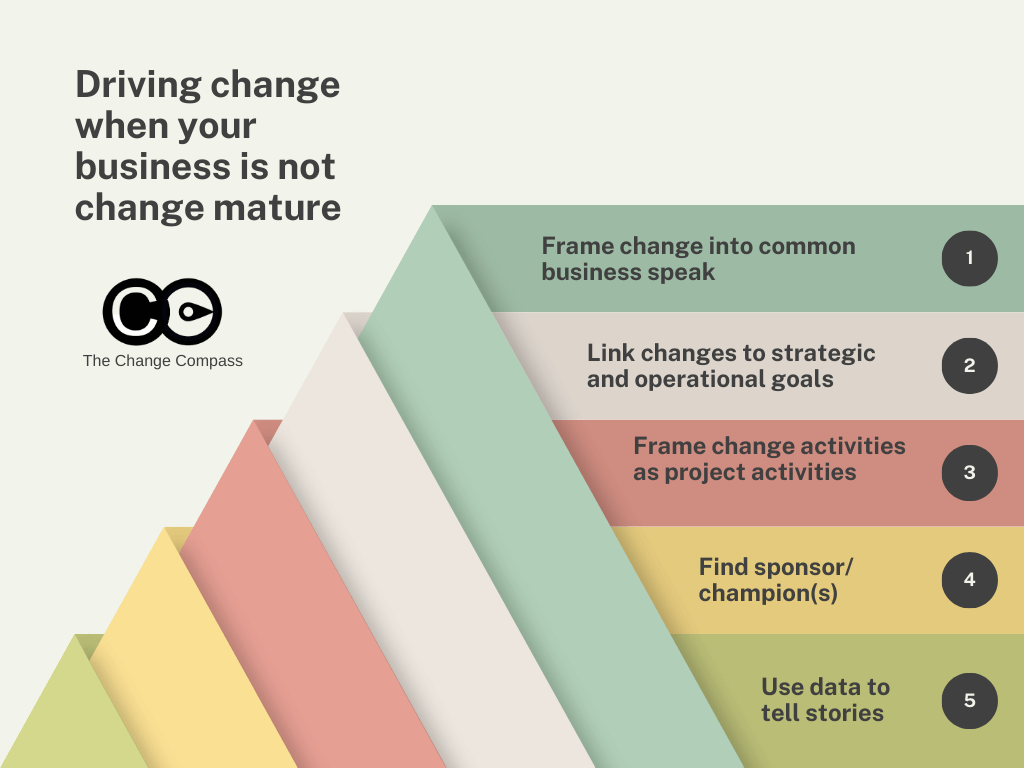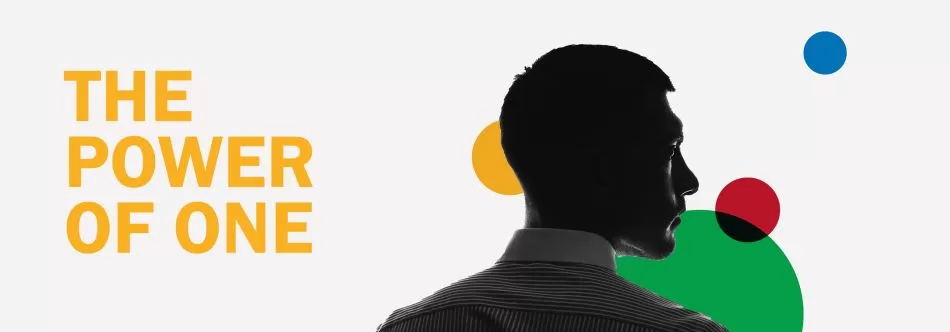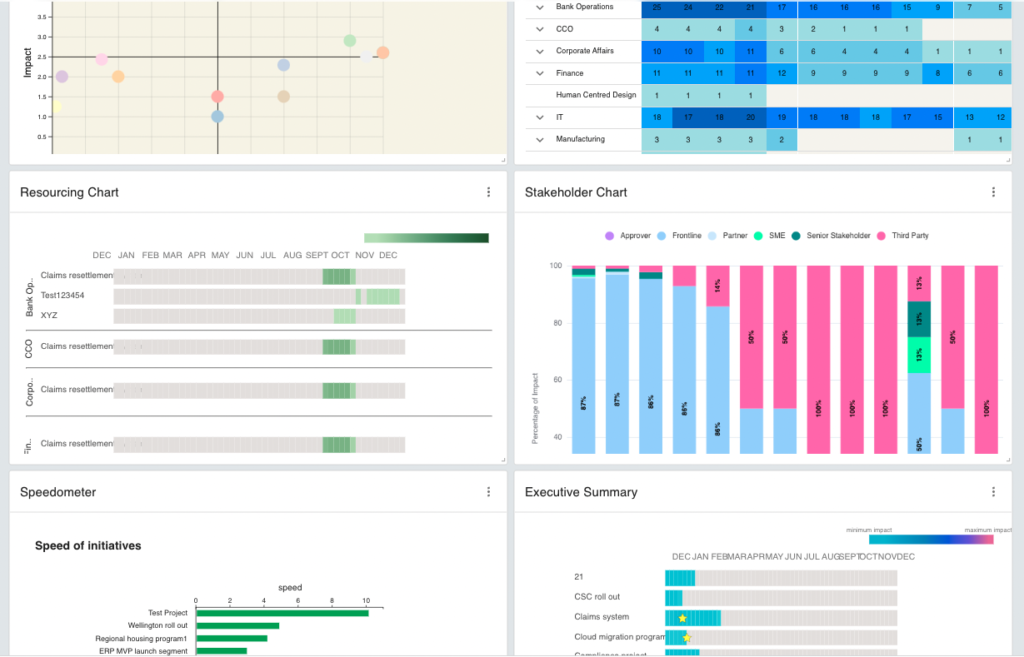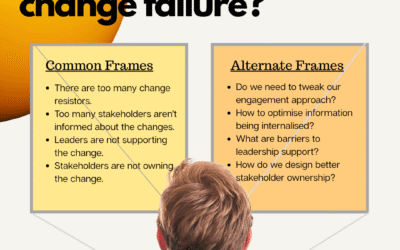Often we hear change practitioners call out the challenges of working with organisations that are not change mature. Yes it is easier for change practitioners to work within organisations that are more mature in managing change. This means that the change concepts and approaches are easily understood and adopted. This also means that you don’t need to spend a lot of time covering the foundational approaches of change before driving project results.
When organisations are less change mature, change practitioners need to do a lot more level setting work to explain their role, and foundational change management concepts. For example, the importance of engagement and authenticity, and getting feedback from stakeholder groups prior to change implementation.
Structured communication and learning channels may need to be setup. Without these being established, messages may not be flowing between the targeted stakeholder groups.
However, every organisation is in a different continuum in their development of their change maturity. How do we work with organisations that simply do not have in place a lot of the foundational capabilities of managing change?

Frame everything as a part of general business management
15 years ago when I was at Intel there was no change management function per se. There were also no dedicated change management professionals. What we know now as change management was covered under the work of Project Managers and the Human Resources Organizational Development function. Most managers were not familiar with change management concepts or applications.
However, from a learning and development perspective what Intel did well was to integrate managing change concepts within general management skills. All levels of management development included a component of managing change. After all, this is an organisation in a fast-changing hi-tech environment where change is a normal part of how the industry evolves.
In particular, first-line manager, second-line manager as well as senior manager development programs all had general management components. Everything ranging from setting clear goals and expectations, communicating clearly, asking for and receiving feedback, driving for results, supporting and developing the team, were all foundational parts of managerial development. As a result, the organisation is quite used to ongoing changes either operational, structural or strategic ones.
The point here is that in order to drive successful change, it may not be necessary to have a dedicated change function nor formalised change management development programs. Change management is a part of general management, just like human resources or operations management.
The challenge for the change practitioner is to diagnose which parts of the fabric of the organisation is not change mature, and therefore could become potential obstacles for successful change process implementation. These may include:
- The ability of targeted leaders in leading change successfully (judging by previous change history)
- The ability of impacted stakeholder groups including employees in trusting leaders in undergoing the change process
- The existence of various learning and engagement platforms and processes from which change implementation may leverage throughout the initiative
- Experience in undergoing change initiatives that follow a structured rigour where stakeholder consultation, ongoing tracking of results, and discipline in execution are adhered to
- Planning capability in engaging stakeholders using clear fact-based visualisation of impact activities and using this to balance and sequence overall business capacity
After identifying those elements that could potentially impede the successful execution and adoption of change, the next task is to ‘frame’ your work around improving business processes and capabilities to support initiative success. And the trick of doing this well in change immature organisations is to frame it without using change concepts or jargon.
As hard as it may seem, some of the terms you may want to avoid include:
- change leadership capability
- burning platform
- change champions
- change vision
- change approach/strategy
- change readiness
I know! This sounds like an impossible feat not to use standard change jargon and concepts. However, this is the key to engaging with organisations that are less change mature. Instead of change-specific language, try using general business terms instead. These are some examples:
- Instead of change leadership capability, leader behaviours required
- Instead of burning platform, articulating the clear reasons for the change
- Instead of change champions, business unit initiative reps
- Instead of change vision, initiative end-state
- Instead of change approach/strategy, leading our people through the initiative
- Instead of change readiness, implementation or initiative readiness

In framing your change approach and plan and ‘translating’ this into business-speak. There are 2 key levels to focus on.
1. Strategic
This is about cutting through to the core of why we are changing and how the change helps to meet a particular strategic goal. For low change mature stakeholders, this needs to be as basic as possible. So, none of the lofty elevator pitches that your corporate communications person has carefully crafted. But, a lay-man wording of why the change is needed and how this helps the organisation.
2. Operational
This is one of the most critical parts of dissecting the change. It is about breaking down your change approach into the various elements that impact the operations of the business. It is laying out the operational activities that are being planned to drive stakeholders through the change process. For example,
- What process changes will mean for the frontline consultant, in terms of work steps, bandwidth, reporting, collaboration, work focus areas, etc.
- What technology changes will team for team work in terms of who does work, the frequency of exchanges, the speed and process of decision making, audit tracing,
Frame change activities as a part of project steps
Another challenge in working with less change mature organisations is positioning project change implementation activities in a way that resonates and make sense. To make things simple for the business, try and use as least jargon as possible and explain the ‘why’ and purpose of each activity.
Here are some examples.
Change impact assessment -> Why is this needed?
- The assessment defines in detail what is changing and how this affects different parts of the organisation, whether is people, process, customer, technology, etc.
- How to use it? After understanding in detail what is changing, this then helps us plan out how to engage the impacted groups of people, and it also helps us to determine how to give them the right skills and support
Stakeholder matrix -> Why is this needed?
- This breaks down which groups of people by business unit, function, team, role, in terms of how we plan to engage with them, using what engagement channels, and how critical or influential they are to the success of the project.
- How to use it? The information on the groups of people impacted by this project determines those we engage with and how we engage with them. It also determines those we need to support with the right skills and know-how. Having the right information of those impacted means that we don’t miss groups of people that we should be engaging with.

It starts with one – finding the first sponsor/champion
Even if less mature organisations there will be managers who ‘get’ what you are trying to do in driving change. They may not know the terminology, the concepts nor the ways to measure change effectiveness. However, experienced managers should intuitively understand the importance of engagement, measurement, setting clear goals and expectations, skills, and capabilities.
When you start to work your way around the organisations you should come across them. They can help to either ‘sponsor’ your project if they are in the right position and their role has the influencing power over your project. He/She may not be the ‘project sponsor’, instead, a political sponsor who is influential enough to create clout to drive movement in the change process.
You may also come across various potential ‘champions’ who are passionate, positive about the change, and diligent enough that you can work with to channel change energy into the various stakeholder groups. These champions may be frontline level, first-line manager, or senior managers.
Remember, any change starts with one person. One by one, the change takes shape and the influence takes place through each interaction and each engagement. Even if you can only have a small number of champions, you will be amazed at the results you can achieve through the dedication of the few.
Use data to tell stories
Even in less change mature organisations, managers use manage to manage the business. This means, if you can gather the right change data to tell the story of how the initiative may pan out across the business, you can easily communicate and influence the business. Especially in less change mature businesses, data is absolutely key.
What are some of the ways in which change data can help to crystalise the importance of change tactics and approaches?

Change impact data can tell a visual and influential story of what is going to happen to the organisation. For example:
- Which parts of the organisation are more impacted? What roles? What are the relative sizes of impact?
- How much time is required for particular roles as part of change implementation activities throughout the implementation phase?
- What’s the timing of implementation activities and how do these overlap with other project activities or operational priorities?
- Scenarios of implementation roadmap including potential risks and benefits of alternative scenarios
Other data can be used to tell stories of the progress of the project include, change readiness assessment results, training completion rates, training session satisfaction feedback, stakeholder readership of knowledge article pages, and attendance and engagement level at briefing or town hall sessions.
To read more about measuring change visit our Ultimate Guide to Measuring Change.






